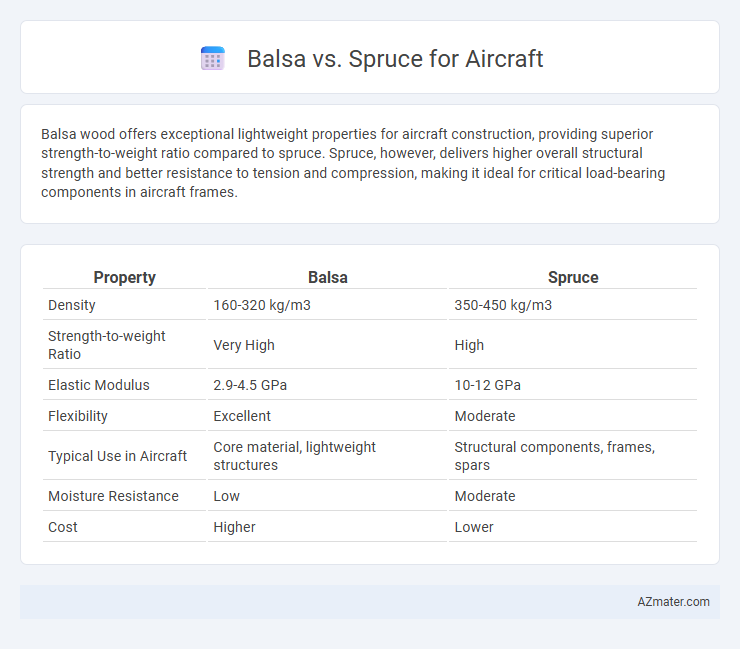Balsa wood offers exceptional lightweight properties for aircraft construction, providing superior strength-to-weight ratio compared to spruce. Spruce, however, delivers higher overall structural strength and better resistance to tension and compression, making it ideal for critical load-bearing components in aircraft frames.
Table of Comparison
| Property | Balsa | Spruce |
|---|---|---|
| Density | 160-320 kg/m3 | 350-450 kg/m3 |
| Strength-to-weight Ratio | Very High | High |
| Elastic Modulus | 2.9-4.5 GPa | 10-12 GPa |
| Flexibility | Excellent | Moderate |
| Typical Use in Aircraft | Core material, lightweight structures | Structural components, frames, spars |
| Moisture Resistance | Low | Moderate |
| Cost | Higher | Lower |
Introduction to Aircraft Wood Selection
Spruce and balsa are the most commonly used woods for building aircraft due to their unique properties; spruce offers exceptional strength-to-weight ratio and durability, making it ideal for structural components like wing spars and longerons. Balsa, known for being extremely lightweight and easy to work with, is frequently used in non-load-bearing parts such as wing ribs and model aircraft construction where weight reduction is critical. Selecting the appropriate wood depends on balancing factors such as tensile strength, density, and workability to optimize aircraft performance and safety.
Overview of Balsa and Spruce Wood
Balsa wood is renowned for its ultra-lightweight yet strong properties, making it a preferred choice for model aircraft and lightweight structures where low density is critical. Spruce wood offers superior tensile strength and rigidity, commonly used in full-scale aircraft framing due to its balanced combination of light weight and structural durability. The natural cellular structure of balsa allows excellent shock absorption, whereas spruce provides better resistance to bending and compression stresses in aircraft applications.
Physical Properties Comparison: Balsa vs Spruce
Balsa wood is significantly lighter, with a density ranging from 100 to 200 kg/m3, compared to spruce, which typically has a density around 350 to 450 kg/m3, making balsa ideal for weight-sensitive aircraft components. Spruce offers superior strength and stiffness, exhibiting a higher modulus of elasticity (approximately 11 GPa) than balsa's 3 to 4 GPa, contributing to better load-bearing capacity in structural elements. Moisture resistance and dimensional stability also favor spruce, which maintains structural integrity under varying environmental conditions better than the more porous balsa.
Strength-to-Weight Ratio: Which is Superior?
Balsa exhibits an exceptional strength-to-weight ratio, making it a preferred choice for lightweight model aircraft where minimizing mass is critical. Spruce, while denser and heavier, offers superior structural strength and durability, favored in full-scale aircraft components requiring high load-bearing capacity. For applications prioritizing minimal weight with reasonable strength, balsa is superior, but spruce excels in scenarios demanding greater toughness and resilience.
Workability and Machining Differences
Balsa wood offers superior workability due to its lightweight, soft texture, and ease of cutting, sanding, and shaping, making it ideal for detailed model aircraft construction. Spruce, being denser and harder, requires sharper tools and more effort for machining but provides greater strength and durability in structural components of aircraft. The choice between balsa and spruce hinges on balancing ease of fabrication with the mechanical properties needed for specific aircraft parts.
Durability and Resistance to Environmental Factors
Spruce offers superior durability and resistance to environmental factors compared to balsa, making it a preferred choice for aircraft structural components. Its tighter grain structure provides enhanced strength, better impact resistance, and improved moisture resistance, which helps in maintaining structural integrity in varying humidity and temperature conditions. Balsa, while lightweight and easy to work with, is more susceptible to damage from water absorption and mechanical stress, limiting its use mostly to non-load-bearing or lightweight applications in aircraft construction.
Cost and Availability for Aircraft Builders
Balsa wood offers a cost-effective and lightweight option for aircraft builders, with widespread availability in hobby and specialty stores, making it ideal for small-scale projects and model aircraft. Spruce, though more expensive, provides superior strength-to-weight ratios and durability, frequently sourced from specialized timber suppliers, which suits structural components in full-scale or high-performance aircraft. Builders must balance budget constraints against material performance, noting that spruce's higher initial cost is often offset by enhanced longevity and safety in critical aircraft sections.
Popular Applications in Aircraft Construction
Balsa wood is prized in aircraft construction for its exceptional lightness and shock absorption, making it ideal for model aircraft and lightweight gliders. Spruce, known for its high strength-to-weight ratio and durability, is commonly used in full-scale aircraft frames, spars, and ribs due to its structural reliability. Both woods play critical roles, with balsa favored in non-structural components and spruced utilized where enhanced load-bearing capacity is essential.
Safety Considerations: Balsa vs Spruce
Balsa, known for its lightweight properties, may compromise structural integrity under high stress, posing safety concerns in critical aircraft components. Spruce offers superior strength-to-weight ratio and durability, enhancing resistance to impact and fatigue, making it a preferred choice for aircraft frames and spars. Proper wood selection, treatment, and inspection are vital to ensure safety when using either wood type in aviation applications.
Choosing the Right Wood for Your Aircraft Project
Balsa and spruce are popular choices for aircraft construction due to their unique properties; balsa offers exceptional lightness with a density around 160 kg/m3, making it ideal for models and low-stress components, while spruce, specifically Sitka spruce, provides superior strength-to-weight ratio and durability essential for structural parts in full-scale aircraft. Selecting the right wood depends on the project's weight constraints, load requirements, and environmental exposure, with spruce preferred for its higher tensile strength and resistance to warping. Proper wood choice enhances performance, safety, and longevity in aircraft design, making material selection a critical step in successful aircraft projects.

Infographic: Balsa vs Spruce for Aircraft
 azmater.com
azmater.com